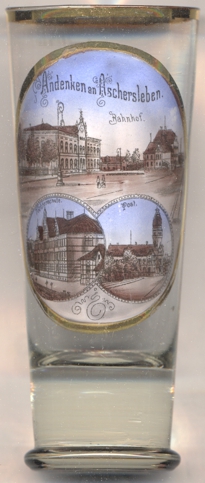

|
| DEUTSCHLAND | GERMANY |
| Bundesland: Sachsen-Anhalt | Saxony-Anhalt |
| Landkreis: Salzlandkreis |
Aschersleben is situated at an elevation of 114 m at the confluence of the rivers Eine and Wipper in the district Salzlandkreis of Germany's state of Sachsen-Anhalt, about 20 west of the district town Bernburg (Saale) and about 42 km southwest of the state's capital, Magdeburg. The municipality has a population of about 26,700 (2020).
The oldest archeological finds of human presence in the area date back to about 55,800 years ago. The earliest known mention in a written document
of Ascegereslebe date from 748 AD. In the 11th century the city passed into the possession of the Ascanian family. Its name came from
Ascania or Ascharia, the Latinized form of Aschersleben Castle. Albrecht the Bear was the head of the House of Askania-Anhalt. He went down
in German history as the Margrave of the Nordmark and even more as the founder of the Mark Brandenburg and was the first to use both names. The branch of
the Anhalt line came into being in 1212. When Albrecht died in 1170, he Ascanians were among the most important dynasties in the Holy Roman Empire and
he left behind a spacious dominion that, in addition to the County of Aschersleben, also included Brandenburg, Saxony-Wittenberg,
Saxony-Lauenburg and parts
of Thuringia. In the course of history, the area was divided frequently among different branches of the family. Aschersleben obtained the privileges of
a town in 1266. After 1315 a decades-long struggle between the princes of Anhalt-Bernburg and the bishops of Halberstadt
broke out. From 1426 until until 1518 Aschersleben was a member of he Hanse federation of trading towns. After the Thirty Years's War (1618–1648) and
 the Peace of Westphalia (1648), Aschersleben became part of the principality of Halberstadt. In 1815 it became part of the Prussian province of Saxony.
After World War II, Aschersleben was part of the German Democratic Republic until 1990, when it became part of Germany's state of Saxony-Anhalt.
The neighbouring municipalities of Drohndorf, Freckleben and Mehringen were incorporated into Aschersleben in 2008; Groß Schierstedt, Neu Königsaue,
Schackenthal and Westdorf followied in 2009, Schackstedt in 2010.
the Peace of Westphalia (1648), Aschersleben became part of the principality of Halberstadt. In 1815 it became part of the Prussian province of Saxony.
After World War II, Aschersleben was part of the German Democratic Republic until 1990, when it became part of Germany's state of Saxony-Anhalt.
The neighbouring municipalities of Drohndorf, Freckleben and Mehringen were incorporated into Aschersleben in 2008; Groß Schierstedt, Neu Königsaue,
Schackenthal and Westdorf followied in 2009, Schackstedt in 2010.
The top picture on glass no. 4189 shows a view of the
 station building
station building
The former  'Höhere Töchterschule' (High School for Girls) [bottom left picture] was built in 1896
and opened in the following year. In 1909 it was recognised as girls' high school. In 1945 parts of the scholl were associated with the Luisenschule. The
schools for boys and girls were merged in 1948. After a through renovation in 1975 the school became part of the Pestalozzi school. The secondary school
Burgschule opened in 1991.
'Höhere Töchterschule' (High School for Girls) [bottom left picture] was built in 1896
and opened in the following year. In 1909 it was recognised as girls' high school. In 1945 parts of the scholl were associated with the Luisenschule. The
schools for boys and girls were merged in 1948. After a through renovation in 1975 the school became part of the Pestalozzi school. The secondary school
Burgschule opened in 1991.
The historic  post office [bottom right picture] was built between 1889 and 1891. Initially, it still had a
tower dome with insulator framework for the telephone and telegraph overhead lines, but this was later removed after the switch to underfloor cabling.
The representative building in the forms of historicism has a facade made of reddish sandstone.
post office [bottom right picture] was built between 1889 and 1891. Initially, it still had a
tower dome with insulator framework for the telephone and telegraph overhead lines, but this was later removed after the switch to underfloor cabling.
The representative building in the forms of historicism has a facade made of reddish sandstone.
[https://de.wikipedia.org/wiki/Aschersleben, https://en.wikipedia.org/wiki/Aschersleben;
https://www.sks-burg-aschersleben.bildung-lsa.de/schule/geschichte/]
![[scale]](lineal.jpg)